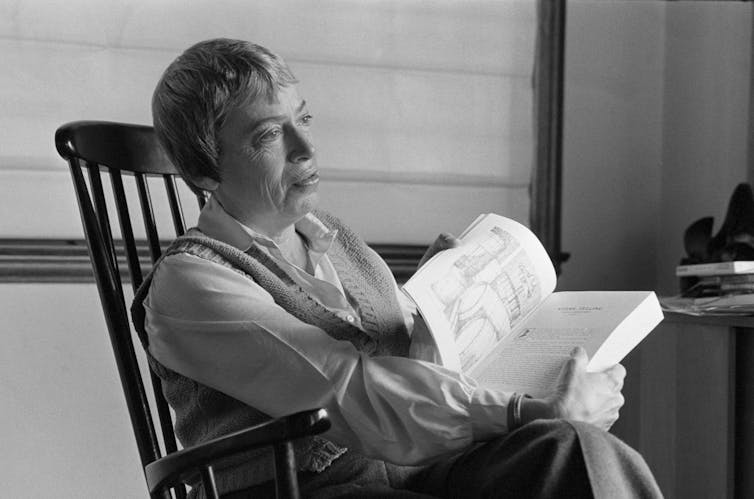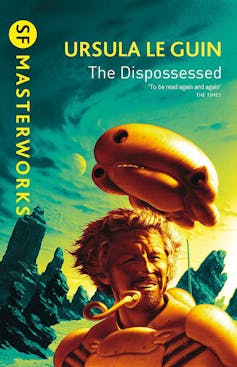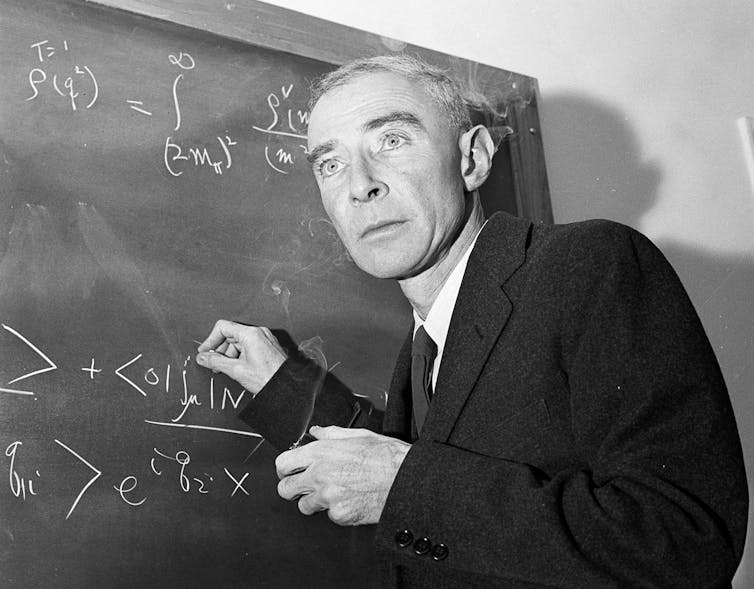Ursula K. Le Guin is one of the most revered science fiction writers of all time. Her groundbreaking science-fiction novel The Dispossessed, written against the backdrop of the Vietnam War, speaks to historically specific forms of geopolitical violence and societal malaise. However, it continues to resonate today.
As I write, less than 200 metres away, pro-Palestinian students are camped out on the University of Sydney’s lawns, protesting the ongoing war in Gaza. These protests are being compared to the Vietnam student protests of 1968, which in part inspired Le Guin’s book.
Le Guin changed science fiction. When she started publishing in the late 1950s, the genre tended to privilege scientific accuracy and technological credibility. But the ethically minded Le Guin used her work to challenge conventional norms and explore alternative societal structures, pushing readers to rethink their perceptions of the world around them.
The novelist Margaret Atwood confirms this:
Le Guin was always asking the same urgent question: what sort of world do you want to live in? Her own choice would have been gender equal, racially equal, economically fair and self-governing, but that was not on offer.

Anthropological sci-fi
The Dispossessed, one of a small handful to win best novel in all three of science fiction’s most prestigious awards (the Hugo, Locus and Nebula), is a fictional thought experiment.
It’s set in what most science fiction authors and aficionados would call a future history: a narrative framework detailing events and developments at a projected point in time, often spanning decades or even centuries.
As a literary device, it affords writers a means to create a cohesive and consistent timeline of future events, societies and technological advances.

The Dispossessed is an integral component of Le Guin’s acclaimed Hainish Cycle, made up of seven novels and multiple short stories. While The Dispossessed is the fifth in the series, its narrative puts it at the chronological beginning. This means it can also be read as a standalone book – or an alternative way into the sequence.
The Hainish Cycle takes place in an alternative universe made up of several human civilisations based on different planets, including a ruined, barely habitable Earth (“Terra”).
Awakening to the realisation that they aren’t the only intelligent beings in the galaxy, these civilisations are in the process of contacting each other for the first time. To differing degrees, they are also striving to forge stable diplomatic relations with their newfound cosmic neighbours.
Le Guin’s father, Alfred Kroeber, was a prominent anthropologist and her mother, Theodora Kroeber, authored a bestselling biography of Ishi, the last known member of the Native American Yahi people.
In a late interview with the journalist Bridget Huber, Le Guin acknowledged how her parents’ anthropological interests influenced her approach to writing:
We’re interested in small details, in getting them right. We’re interested in how people do things and what things they do and how they explain doing them. This is all kind of anthropological information. […] It’s what you build novels out of: human relationships, how people arrange their relationships.
This anthropological approach makes its way more literally into The Dispossessed: its most inquisitive denizens are trying to figure out what makes their counterparts in neighbouring worlds tick, and better understand how they are structured.
Intergalactic colonisers and naked imperialism
These efforts are being facilitated by the Hainish people, the oldest known civilisation in existence. The Terran Ambassador Keng, who we meet towards the end of The Dispossessed, says of them:
They treat us gently, charitably, as the strong man treats the sick. […] They are moved by a guilt we don’t even understand, despite all our crimes. They are moved in all they do, I think, by the past, their endless past.
What Keng doesn’t articulate here, but becomes clear as Le Guin’s exercise in world-building unfurls, is that the Hainish were once a band of intergalactic colonisers. Indeed, the roots of all of the human civilisations we encounter in this expansive fictional universe can be traced back to Hain.
Colonialism emerges as a central theme within the Hainish Cycle. Le Guin’s 1972 allegorical novella, The Word for World is Forest, is a blistering critique of the United States’ nakedly imperialistic conduct in Vietnam.
In the introduction to the 1976 reprint, Le Guin reflected on its historical context, pulling no punches:
1968 was a bitter year for those who opposed the war. The lies and hypocrisies redoubled; so did the killing. Moreover, it was becoming clear that the ethic which approved the defoliation of forests and grainlands and the murder of non-combatants in the name of “peace” was only a corollary of the ethic which permits the despoliation of natural resources for private profit or the GNP, and the murder of the creatures of the Earth in the name of “man”.

Not war, but peace
These pressing matters continued to weigh on Le Guin when she started work on The Dispossessed, which began, she said, as “a very bad short story”.
There was a book in it, and I knew it, but the book had to wait […] I needed to understand my own passionate opposition to the war that we were, endlessly it seemed, waging in Vietnam, and endlessly protesting at home.
Certain she didn’t want to study war anymore, Le Guin decided to turn her attention to the topic of peace. She started by “reading a whole mess of utopias and learning something about pacifism and Gandhi and nonviolent resistance”.
This led her to the nonviolent anarchism of Peter Kropotkin and Paul Goodman, with whom she felt “a great, immediate affinity”. These writers “made sense” to her in the same way the ancient Taoist philosopher Lao Tzu did: they helped Le Guin “to think about war, peace, politics, how we govern one another and ourselves, the value of failure, and the strength of what is weak.”
She explains “when I realised that nobody had yet written an anarchist utopia, I finally began to see what my book might be”.
The book’s principle character, an idealistic theoretical physicist named Shevek, was partially based on Robert Oppenheimer, a friend of Le Guin’s parents. Shevek hails from the desert moon Anarres, one of the two inhabited planets in the Tau Ceti system. The other inhabited world is a technologically advanced planet called Urras.
While he is an Anarresti citizen, Shevek usually refers to himself as an Odonian. This marks him as a follower of Odo, a radical female philosopher and activist, who died 200 years or so before the events of The Dispossessed take place.

‘She is the revolution’
Odo, who spends her entire life on Urras, grows increasingly disillusioned with the capitalistic and authoritarian structures that dominate and disfigure her world and the people in it. She becomes a political agitator and publishes anarchist treatises, calling for the abolition of the state and the founding of a truly egalitarian society.
Odo’s ideas quickly start to gain traction. The state locks her up for nine years, but undeterred, she continues to write. Odo’s influence grows, and her supporters come to think of her in messianic terms. She becomes a symbolic focal point for increasingly concentrated revolutionary energies to collect and swirl around.
As the literary critic Brian Attebery notes, Odo becomes “the source, the spark: she is the revolution”. He continues:
It is a revolution beyond any in history: a leap to a new language, a new way of life, a new kind of society, a new planet.
Fearing the anarchist tide, the Urrasti government extends an offer to Odo’s followers: migrate to Anarres and we’ll leave you in peace. Over decades, the colony on Anarres evolves into a functioning anarchist enclave, with the populace largely isolated. This is where The Dispossessed starts.
The plot hinges on Shevek’s struggle to reconcile two antithetical conceptions of time: the idea that time is linear and successive, and the notion that time is cyclical and eternal.
In an unprecedented and contentious move, he travels to Urras to collaborate with scientists and scholars, in an attempt to complete and publish his groundbreaking theory, which has the potential to totally reshape ways of life, as well as modes of transportation and communication.
The Urrasti roll out the red carpet. Feted on arrival, Shevek is taken on various tours and excursions. He had expected to feel lost and confused but “he felt nothing of the kind”. He is dazzled by “this incredibly complex society with all its nations, classes, cults, customs, and its magnificent, appalling, and interminable history”.
Over time, however, Shevek comes to despise the vulgar “propertarians” he meets on Urras:
There is nothing you can do that profit does not enter in, and fear of loss, and the wish for power. You cannot say good morning without knowing which of you is “superior” to the other, or trying to prove it. You cannot act like a brother to other people, you must manipulate them, or command them, or obey them, or trick them.
He also realises he has been duped: the Urrasti aren’t interested in sharing scientific knowledge; they want to weaponise it in order to further their imperial ambitions.
‘A space opened for change’
One particular moment in The Dispossessed stands out for me. It comes during Shevek’s meeting with Keng. Shevek is discussing what he has learnt about Urrasti society:
Urras is a box, a package, with all the beautiful wrapping of blue sky and meadows and forests and great cities. And you open the box, and what is inside it? A black cellar full of dust, and a dead man. A man whose hand was shot off because he held it out to others. I have been in Hell at last.
The sentiment of this visceral passage brings to mind a famous short story Le Guin published in 1973: The Ones Who Walk Away from Omelas. Often read in conjunction with The Dispossessed, the story centres on a prosperous and peaceful utopian society:
They did not use swords, or keep slaves. They were not barbarians. I do not know the rules and laws of their society, but I suspect they were singularly few. As they did without monarchy and slavery, so they also got on without the stock exchange, the advertisement, the secret police, and the bomb.
The citizens of Omelas are a happy and joyous bunch. However, it is later revealed that their collective contentment is dependent on a sordid little secret. This idyllic state of societal affairs is entirely dependent on one innocent child being imprisoned forever in a dim and dingy basement, with little food and no human contact.
“They all know it is there,” Le Guin writes, “Some of them have come to see it; others are content merely to know it is there.” As a rule, when children in Omelas come of age, they are taken to see the child. The situation is explained to them:
Often the young people go home in tears, or in a tearless rage, when they have seen the child and faced this terrible paradox. They may brood over it for weeks or years. But as time goes on they begin to realise that even if the child could be released, it would not get much good of its freedom.
In other words: confronted with the unpalatable truth and “bitter injustice” of the situation, the people of Omelas opt to turn a blind eye. At least, the majority of them do. Others reject complicity:
These people go out into the street, and walk down the street alone. They keep walking, and walk straight out of the city of Omelas, through the beautiful gates.
Thinking again of the pro-Palestinian protesters camped out not far from my office, I wonder what Le Guin, with her longstanding commitment to nonviolent forms of civil disobedience, would make of such a situation.
In lieu of a definitive answer, I’ll close with a passage from one of Le Guin’s most memorable essays, which, like The Dispossessed, reflects on oppression and revolution, and is alive to utopian possibility and paradox:
The shift from denial of injustice to recognition of injustice can’t be unmade. What your eyes have seen they have seen. […] From now on, if you don’t resist, you collude. But there is a middle ground between defence and attack, a ground of flexible resistance, a space opened for change. It is not an easy place to find or live in.

